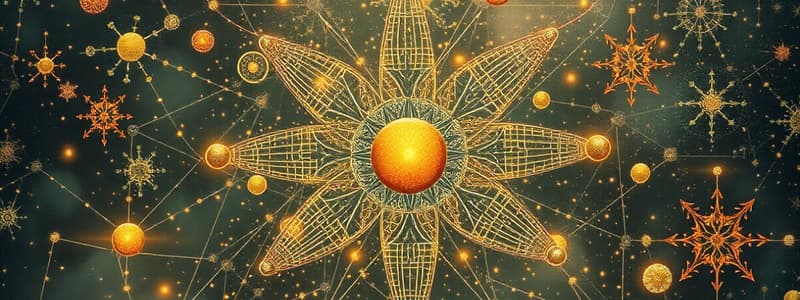Podcast
Questions and Answers
Atoms are the tiny building blocks that make up all ______.
Atoms are the tiny building blocks that make up all ______.
materials
The particulate nature of matter refers to materials being made up of small ______.
The particulate nature of matter refers to materials being made up of small ______.
particles
Democritus theorized that tiny particles could not be broken down into even smaller ______.
Democritus theorized that tiny particles could not be broken down into even smaller ______.
particles
John Dalton's atomic theory states that all matter is made up of very small particles called ______.
John Dalton's atomic theory states that all matter is made up of very small particles called ______.
Cathode rays are streams of negatively charged particles called ______.
Cathode rays are streams of negatively charged particles called ______.
J.J. Thomson found that the rays were attracted to the positive ______.
J.J. Thomson found that the rays were attracted to the positive ______.
Thomson could cancel out the attractive forces using a ______ field.
Thomson could cancel out the attractive forces using a ______ field.
William Crookes demonstrated that cathode rays travel in ______ lines.
William Crookes demonstrated that cathode rays travel in ______ lines.
Robert Millikan conducted the oil drop experiment to determine the charge on an ______.
Robert Millikan conducted the oil drop experiment to determine the charge on an ______.
Millikan calculated the charge on an electron as 1.6 x 10^[-blank] coulomb.
Millikan calculated the charge on an electron as 1.6 x 10^[-blank] coulomb.
In 1898, J.J. Thomson proposed the ‘Plum Pudding’ model of the ______.
In 1898, J.J. Thomson proposed the ‘Plum Pudding’ model of the ______.
Ernest Rutherford discovered the ______ by bombarding gold foil with positively charged alpha particles.
Ernest Rutherford discovered the ______ by bombarding gold foil with positively charged alpha particles.
Rutherford concluded that most of the atom is made up of ______ space.
Rutherford concluded that most of the atom is made up of ______ space.
James Chadwick discovered the ______ in 1932 by bombarding beryllium with alpha particles.
James Chadwick discovered the ______ in 1932 by bombarding beryllium with alpha particles.
The small positively charged particles discovered by Rutherford are called ______.
The small positively charged particles discovered by Rutherford are called ______.
In Millikan's experiment, oil droplets became negatively charged by picking up ______.
In Millikan's experiment, oil droplets became negatively charged by picking up ______.
Flashcards
Atom
Atom
The tiny building block of all matter.
Particulate Nature of Matter
Particulate Nature of Matter
The idea that all matter is made up of tiny particles.
Cathode Rays
Cathode Rays
Streams of negatively charged particles called electrons.
Electrons
Electrons
Signup and view all the flashcards
Dalton's Atomic Theory (Point 1)
Dalton's Atomic Theory (Point 1)
Signup and view all the flashcards
Dalton's Atomic Theory (Point 2)
Dalton's Atomic Theory (Point 2)
Signup and view all the flashcards
Crookes' Experiment
Crookes' Experiment
Signup and view all the flashcards
Thomson's Experiment
Thomson's Experiment
Signup and view all the flashcards
Oil Drop Experiment
Oil Drop Experiment
Signup and view all the flashcards
Charge of an Electron
Charge of an Electron
Signup and view all the flashcards
Rutherford's Gold Foil Experiment
Rutherford's Gold Foil Experiment
Signup and view all the flashcards
Discovery of the Nucleus
Discovery of the Nucleus
Signup and view all the flashcards
Alpha Particles
Alpha Particles
Signup and view all the flashcards
Discovery of the Proton
Discovery of the Proton
Signup and view all the flashcards
Discovery of the Neutron
Discovery of the Neutron
Signup and view all the flashcards
Thomson's Model of the Atom
Thomson's Model of the Atom
Signup and view all the flashcards
Study Notes
Atomic Structure
- Atoms are the fundamental building blocks of matter
- Democritus (400 BC) theorized that matter was composed of indivisible particles
- John Dalton (1808) proposed an atomic theory: all matter is composed of atoms, atoms are indivisible, and atoms of the same element are identical.
- William Crookes (1875) experimented with cathode rays, observing they traveled in straight lines, were deflected by electric and magnetic fields, and had enough energy to move a paddle wheel.
- Cathode rays are streams of negatively charged particles called electrons.
- J.J. Thomson (1897) discovered the electron, determining the ratio of its charge to mass. Atoms are divisible
- Thomson proposed the "plum pudding" model: a diffuse positive charge with electrons embedded within.
- Robert Millikan (1909) determined the charge of an electron accurately
- Ernest Rutherford (1909) discovered the nucleus by bombarding gold foil with alpha particles.
- Most alpha particles passed straight through, some were deflected at large angles, and some bounced back.
- Rutherford concluded that the atom is mostly empty space with a dense, positively charged nucleus.
- James Chadwick (1932) discovered the neutron, a particle with no charge and roughly the same mass as a proton.
Subatomic Particles
- Proton: Positively charged particle, located in the nucleus, relative mass of 1, relative charge of +1.
- Neutron: Uncharged particle, located in the nucleus, relative mass of 1, relative charge of 0.
- Electron: Negatively charged particle, located outside the nucleus, relative mass of very small, relative charge of -1.
Studying That Suits You
Use AI to generate personalized quizzes and flashcards to suit your learning preferences.



